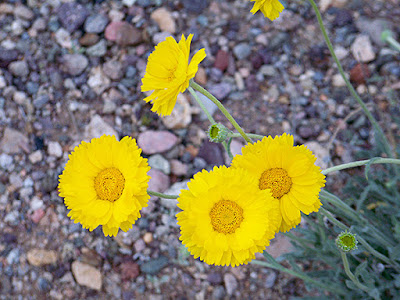Winter rains have been good this year, and wildflowers grow
in profusion beside our neighborhood walking path. As local government decrees
keep us closer to home (most recently we have been strongly advised by our mayor to stay there as much as possible), a small group of us walk our dogs at the same time each morning, maintaining social distancing.
The colors of these wildflowers are deeper and more vibrant than the colors of wildflowers I remember back East. Their English names, which I learned when I first came to
Arizona, often simply add the word “desert” to the names of common garden flowers.
 |
| Desert penstemon |
There are many spikes of desert penstemon, their pink flowers like
small trumpets calling bees and hummingbirds. Half a dozen or more stems cluster together and grow 2-3 feet tall.
 |
| Brittlebush |
We don’t have Mexican gold poppies here, but yellow-flowered
brittlebush seems to be everywhere, and each plant is filled with dozens of
blooms. There are also desert marigolds and other, smaller, less showy yellow
flowers, too.
 |
| Desert marigold |
Desert verbena is low to the ground and less plentiful, but
its blue-violet blooms are fragrant and long-lasting.
 |
| Desert verbena |
And then there's desert globemallow, with many orange, cup-shaped flowers on each shrubby plant.
 |
| Desert globemallow |
After our walk the other day, as Greg and I headed for home,
we saw a turkey vulture on top of a phone pole, wings raised to the morning
sun. This action, like our frequent handwashing during this time of COVID-19,
is a way to vanquish microbes. The raised wings make the big bird look like a
supplicant, its red head vulnerable in the early morning light.
 |
| Turkey vulture with one wing raised |
The vulture is a living symbol, bearing its guilt by
association as a carrion eater, and so our morning walk was like a living vanitas. Those paintings were intended to remind us of our own mortality — telling us to remember that life is very
short and we will all die. Symbols found in
vanitas paintings often include skulls, fruit, and flowers, but a vulture will
certainly do as a reminder that all is vanity.
 |
| Aloe vera flowers |
Even so, as we walked through the back gate, I noticed how
much progress spring is making -- the succulents are starting to bloom and
get new growth. The aloe vera plants are sending up spiny stalks and unfolding
orange flowers. The prickly pear cactus are making lots of undifferentiated buds
that are hard to tell apart at first but it soon becomes clear which will be
flowers and which will be new pads.
 |
| Prickly pear budding |
And though I am existentialist enough to think frequently
about how short life is, I still wanted to show off my pictures and say what I think about them. Because all may be vanity, but the world is still a
sight to behold.



No comments:
Post a Comment